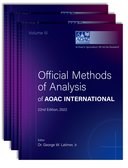 Official Methods of Analysis of AOAC INTERNATIONAL (22nd Edition)
Official Methods of Analysis of AOAC INTERNATIONAL (22nd Edition)
Contents
32.2.09
AOAC Official Method 945.39
Loss on Drying (Moisture) in Soybean Flour
Get access
-
Published:January 2023
Cite
Loss on Drying (Moisture) in Soybean Flour', in Dr. George W Latimer, Jr. (ed.), Official Methods of Analysis of AOAC INTERNATIONAL, 22nd Edition (
Extract
First Action 1945
Final Action
Moisture
Proceed as in 925.10 (see 32.1.03), except use 5 g test portion and dry 2 h.
Ash; Crude Fiber
See 942.05 (see 4.1.10); 962.09E (see 4.6.01).
Nitrogen
See 920.87 (see 32.1.22).
Petroleum Ether Extract or Oil
Reagent
Petroleum ether.—Initial boiling temperature, 35–38°C; dry-flask end point, 52–60°C; ≥95% distilling ≤54°C, and ≤60% distilling ≤40°C; specific gravity at 60°F (15.6°C), 0.630–0.660; evaporation residue ≤0.002% by weight.
Determination
Accurately weigh duplicate test portions of 2 g full-fat or 5 g low-fat soy flour and wrap each portion in 150 mm filter paper (No. 597 Schleicher and Schuell or equivalent); rewrap in second paper or papers so as to prevent escape of test portion, leaving top of second paper open like thimble. Place piece of absorbent cotton in top of thimble to distribute the dropping ether. Place 25 mL petroleum ether in 125 mL tared flask, and extract test portion 5 h in Butt-type or similar extractor. (Ether should drop on center of thimble at rate of ≥150 drops/min, and volume solvent should be kept ca constant.) Evaporate solvent until no trace remains, cool residue to room temperature, and weigh. As last traces of ether are sometimes difficult to detect by odor, heat ≥1 h to constant weight.
Sign in
Personal account
- Sign in with email/username & password
- Get email alerts
- Save searches
- Purchase content
- Activate your purchase/trial code
- Add your ORCID iD
Purchase
Our books are available by subscription or purchase to libraries and institutions.
Purchasing information| Month: | Total Views: |
|---|---|
| April 2024 | 8 |
| May 2024 | 3 |
| June 2024 | 8 |
| July 2024 | 12 |
| August 2024 | 4 |
| September 2024 | 4 |
| October 2024 | 5 |
| November 2024 | 1 |
| December 2024 | 9 |
| January 2025 | 11 |
| February 2025 | 3 |
| March 2025 | 13 |
| April 2025 | 4 |




Get help with access
Institutional access
Access to content on Oxford Academic is often provided through institutional subscriptions and purchases. If you are a member of an institution with an active account, you may be able to access content in one of the following ways:
IP based access
Typically, access is provided across an institutional network to a range of IP addresses. This authentication occurs automatically, and it is not possible to sign out of an IP authenticated account.
Sign in through your institution
Choose this option to get remote access when outside your institution. Shibboleth/Open Athens technology is used to provide single sign-on between your institution’s website and Oxford Academic.
If your institution is not listed or you cannot sign in to your institution’s website, please contact your librarian or administrator.
Sign in with a library card
Enter your library card number to sign in. If you cannot sign in, please contact your librarian.
Society Members
Society member access to a journal is achieved in one of the following ways:
Sign in through society site
Many societies offer single sign-on between the society website and Oxford Academic. If you see ‘Sign in through society site’ in the sign in pane within a journal:
If you do not have a society account or have forgotten your username or password, please contact your society.
Sign in using a personal account
Some societies use Oxford Academic personal accounts to provide access to their members. See below.
Personal account
A personal account can be used to get email alerts, save searches, purchase content, and activate subscriptions.
Some societies use Oxford Academic personal accounts to provide access to their members.
Viewing your signed in accounts
Click the account icon in the top right to:
Signed in but can't access content
Oxford Academic is home to a wide variety of products. The institutional subscription may not cover the content that you are trying to access. If you believe you should have access to that content, please contact your librarian.
Institutional account management
For librarians and administrators, your personal account also provides access to institutional account management. Here you will find options to view and activate subscriptions, manage institutional settings and access options, access usage statistics, and more.